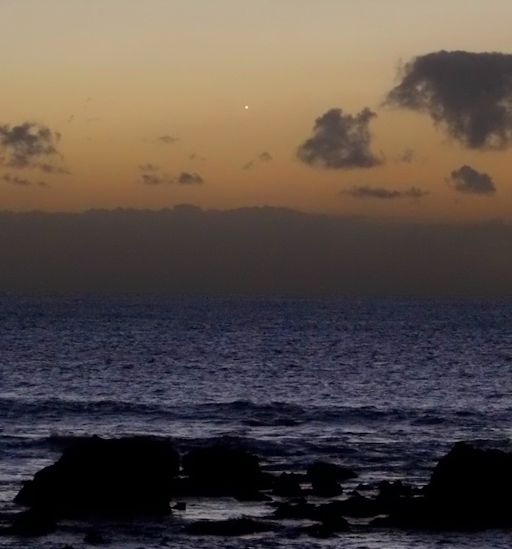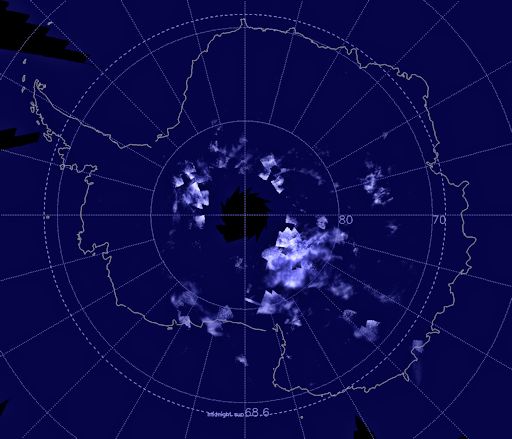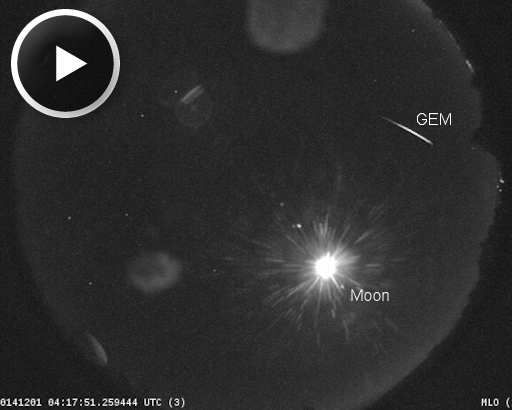Learn to photograph Northern Lights like a pro. Sign up for Peter Rosen's Aurora Photo Courses in Abisko National Park. | | |
MILD SPACE WEATHER FAVORS ORION LAUNCH: This Thursday, Dec. 4th, NASA will conduct a test launch of Orion, the first spacecraft built for astronauts to travel through deep space since the Apollo missions of the 1960s and 70s. With only a slight 5% chance of X-class solar flares, the space weather forecast favors a trouble-free launch. Terrestrial weather looks good, too. Stay tuned for an historic launch. Solar flare alerts: text, voice
THE RETURN OF THE EVENING STAR: For the past two months Venus has been passing behind the sun. Now the second planet is emerging from the glare, setting the stage for The Return of the Evening Star. Yesterday in Spain, the astrophotography group Project Nightflight spotted the silvery light of Venus beaming through the Atlantic sunset:

"Venus is beginning a new evening apparition," says Project Nightflight. "After sunset it is very low in the sky and sets quickly. To catch a glimpse of the Evening Star, you will need crisp skies and an unobstructed view of the western horizon. A pair of binoculars will help spot it."
"Visibility will improve during the weeks ahead," they add. "By the end of December, Venus should be plainly visible even from mid northern latitudes."
A date of particular interest is Dec. 22nd when a super-slender 2% crescent Moon will pass Venus in the evening twilight. Astrophotographers, ready your cameras!
Realtime Space Weather Photo Gallery
ELECTRIC-BLUE CLOUDS SPREADING OVER ANTARCTICA: Noctilucent clouds (NLCs) around the south pole are spreading and brightening. The latest preliminary image from NASA's AIM spacecraft shows more than 4 times the coverage of just a few days ago:

The season for southern hemisphere noctilucent clouds (NLCs) began on Nov. 22nd with just a few puffy clouds over the frozen continent. Once NLCs first appear, AIM has shown that they rapidly multiply. Indeed, this is happening now, and much of Antarctica soon could be blanketed in electric blue.
Earlier this year, AIM researchers announced a surprising teleconnection: The apparition of NLCs in the southern hemisphere is linked to cold air temperatures thousands of miles away in the northern hemisphere."For example, we found that the winter air temperature in Indianapolis, Indiana, is well correlated with the frequency of noctilucent clouds over Antarctica," says Cora Randall, AIM science team member and Chair of the Dept. of Atmospheric and Oceanic Sciences at the University of Colorado. Other US cities were similarly correlated.
Data from previous seasons show a 2-week time lag between cold outbreaks in the north and changes to NLCs in the south. However, because the 2014-2015 season is less than two weeks old, the correlation is not yet obvious. "I don't expect the northern hemisphere (NH) teleconnection signal to have significant effects on the onset of the southern hemisphere (SH) season for noctilucent clouds," says Randall. "But once planetary wave activity in the SH stratosphere is quiet (should be soon), then I would expect the connections with the NH winter to become more evident."
Randall and a group of colleagues led by Laura Holt of NorthWest Research Associates have just submitted a paper to the Geophysical Research Letters detailing the link between northern winter and southern NLCs. If you have a GRL subscription, keep an eye out for theirfuture article entitled "Summertime polar mesospheric clouds linked to wintertime surface cold air outbreaks."
Realtime NLC Photo Gallery
GEMINID METEOR SHOWER: Earth is entering a stream of gravelly debris from "rock comet" 3200 Phaethon, source of the annual Geminid Geminid meteor shower. On the night of Nov. 30-Dec. 1, NASA's network of all-sky cameras detected three Geminid fireballs over the USA. This specimen from the desert southwest was clearly visible despite the glare from the waxing gibbous Moon:

The Geminid hit Earth's atmosphere traveling 32 km/s (72 thousand mph) and disintegrated completely 73 km (45 miles) above Earth's surface. These values are typical of Geminids.
Meteor sightings will increase in the nights ahead as Earth plunges deeper into the debris stream. Forecasters expect peak rates to occur on Dec. 13-14, when dark-sky observers in both hemispheres could see as many as 120 meteors per hour. Stay tuned for updates and, meanwhile, listen for Geminid echoes in the audio feed from our live meteor radar. Meteor alerts: text, voice
Realtime Aurora Photo Gallery
Realtime Comet Photo Gallery
Every night, a network of NASA all-sky cameras scans the skies above the United States for meteoritic fireballs. Automated software maintained by NASA's Meteoroid Environment Office calculates their orbits, velocity, penetration depth in Earth's atmosphere and many other characteristics. Daily results are presented here on Spaceweather.com.
On Dec. 3, 2014, the network reported 4 fireballs.
(4 sporadics)

In this diagram of the inner solar system, all of the fireball orbits intersect at a single point--Earth. The orbits are color-coded by velocity, from slow (red) to fast (blue). [Larger image] [movies]
Potentially Hazardous Asteroids (
PHAs) are space rocks larger than approximately 100m that can come closer to Earth than 0.05 AU. None of the known PHAs is on a collision course with our planet, although astronomers are finding
new ones all the time.
On December 3, 2014 there were potentially hazardous asteroids.
Notes: LD means "Lunar Distance." 1 LD = 384,401 km, the distance between Earth and the Moon. 1 LD also equals 0.00256 AU. MAG is the visual magnitude of the asteroid on the date of closest approach. | | The official U.S. government space weather bureau |
| | The first place to look for information about sundogs, pillars, rainbows and related phenomena. |
| | Researchers call it a "Hubble for the sun." SDO is the most advanced solar observatory ever. |
| | 3D views of the sun from NASA's Solar and Terrestrial Relations Observatory |
| | Realtime and archival images of the Sun from SOHO. |
| | from the NOAA Space Environment Center |
| | the underlying science of space weather |

